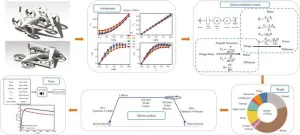(Press-News.org) Researchers at Baylor College of Medicine and collaborating institutions have uncovered new potential therapeutic targets for cancer and new insights into existing cancer drug targets, expanding the breadth of possibilities for treating this disease. Using a comprehensive approach that included integrating proteomics, genomics and epigenomics data from 10 cancer types, the team identified protein and small protein or peptide targets in cancer tissues and validated many of them experimentally as promising candidates for therapeutic strategies. The study appeared in Cell.
“Experience has shown that targeted therapies, cancer treatments directed at specific proteins in cancer cells, hold promise for achieving more effective clinical results than traditional radiotherapy and chemotherapy,” said co-corresponding author Dr. Bing Zhang, professor of molecular and human genetics and part of the Lester and Sue Smith Breast Center at Baylor. “Although there is progress identifying potential vulnerabilities of specific cancer types, fewer than 200 proteins are targeted by FDA-approved cancer drugs. In this study we significantly expanded the list of potential therapeutic targets by analyzing data from more than 1,000 tissue samples spanning 10 cancer types.”
The researchers applied computational tools to integrate proteogenomic data comprising genome-wide information on DNA, RNA and proteins that was generated by the Clinical Proteomic Tumor Analysis Consortium (CPTAC) from prospectively collected samples of treatment-naïve primary tumors, many with matched normal adjacent tissues for comparison. The team integrated the CPTAC dataset with other public datasets to investigate the similarities and differences among gene and protein alterations found in diverse tumor types to illuminate protein targets for cancer therapy.
“Our goal was to better understand the characteristics of known drug targets. We also hoped to identify new targets that could lead to new drug developments,” said Zhang, a McNair scholar and member of Baylor’s Dan L Duncan Comprehensive Cancer Center.
The team applied the data integration approach to systematically identify proteins and genes that are important for cancer growth and development. For instance, proteins that are overexpressed or hyperactive in cancer tissues but not in normal counterparts, and loss of tumor suppressor genes, which can create dependencies on other proteins that could then be therapeutically targeted. They also searched for tumor antigens, including neoantigens – cancer-specific peptides derived from gene mutations in tumors.
“Our study revealed new opportunities for repurposing drugs currently approved for other conditions,” Zhang said. “For example, we show that an antifungal drug can also reduce growth of several cancer types, supporting further exploration of the anti-cancer value of this drug.”
The researchers also identified potential protein targets currently without a drug – some are enzymes called kinases and others are cell surface proteins. “These findings open opportunities for drug development, including small-molecule drugs or drug-antibody conjugates,” Zhang said.
Furthermore, computational identification of several tumor-associated proteins shared among different cancer types was followed by experimental confirmation of their importance for cancer in cells grown in the lab and in animal models, validating these proteins as potential therapeutic targets worthy of more study.
“I am very excited that we have created a comprehensive resource of protein targets, significantly expanding the therapeutic landscape by identifying many new candidates and covering various therapeutic modalities. And we have made our findings publicly available at https://targets.linkedomics.org,” Zhang said. “We hope that this resource will pave the way to repurposing currently available drugs and developing new therapies for cancer treatment.”
Sara R. Savage, Xinpei Yi, Jonathan T. Lei, Bo Wen, Hongwei Zhao, Yuxing Liao, Eric J. Jaehnig, Lauren K. Somes, Paul W. Shafer, Tobie D. Lee, Zile Fu, Yongchao Dou, Zhiao Shi, Daming Gao, Valentina Hoyos and Qiang Gao contributed to this work. The authors are affiliated with one of the following institutions: Baylor College of Medicine, Fudan University – China or the Chinese Academy of Sciences.
This work was supported by National Institutes of Health grants from the National Cancer Institute (U24 CA210954, U24 CA271076, R01 CA245903, U01CA271247 and P50 CA058183), Cancer Prevention & Research Institute of Texas (CPRIT) Awards (RR160027 and RR170024) and funding from the McNair Medical Institute at The Robert and Janice McNair Foundation. Further support was provided by training grant T32 GM1364554, the National Natural Science Foundation of China (grant 81961128025), CPRIT scholarships in cancer research and a McNair scholarship.
###
END
Study reveals new opportunities to develop cancer treatments
2024-06-24
ELSE PRESS RELEASES FROM THIS DATE:
Bezos Center for Sustainable Protein launches at Imperial with $30M funding
2024-06-24
Bezos Earth Fund grant establishes new Centre at Imperial to transform global food systems from environmentally damaging to innovative by creating sustainable solutions.
Imperial’s Bezos Centre for Sustainable Protein, launched today, will develop innovative and evidence-based solutions through the design, delivery, and commercialisation of alternative food products that are economically and environmentally friendly, nutritious, affordable, and tasty.
The Centre, spanning across seven Imperial academic departments, will advance research into precision fermentation, cultivated meat, bioprocessing and automation, ...
Star clusters observed within a galaxy in the early Universe for the first time
2024-06-24
The history of how stars and galaxies came to be and evolved into the present day remains among the most challenging astrophysical questions to solve yet, but new research brings us closer to understanding it.
In a new study by an international team led by Dr. Angela Adamo at Stockholm University, new insights about young galaxies during the Epoch of Reionization have been revealed. Observations with the James Webb Space Telescope (JWST) of the galaxy Cosmic Gems arc (SPT0615-JD) have confirmed that the light of the galaxy was emitted 460 million years after ...
How much oxygen do very premature babies need after birth?
2024-06-24
Giving very premature babies high concentrations of oxygen soon after birth may reduce the risk of death by 50 percent, compared to lower levels of oxygen says new research led by University of Sydney researchers.
When premature babies are born, they sometimes need help breathing because their lungs haven’t finished developing. To help babies during this process, doctors may give them extra oxygen through a breathing mask or breathing tube.
The study, published in JAMA Pediatrics, examined clinical trial data and outcomes of ...
Trial offers hope for cheaper, more tolerable, ketamine treatment
2024-06-24
For those suffering from treatment-resistant depression, the anaesthetic drug ketamine offers hope, but it has side effects and can be costly to access – a University of Otago-led clinical trial may change that.
Working in collaboration with New Zealand’s Douglas Pharmaceuticals, researchers have conducted a trial of ketamine in an extended-release tablet form.
The study, published in prestigious international journal Nature Medicine, involved 168 adults for whom regular anti-depressant therapy ...
Fertility treatments could get boost from stem cells
2024-06-24
An unexpectedly versatile and regenerative stem cell in early embryos may be key to creating new effective fertility treatments, suggests a new study in mice from the University of Copenhagen.
It probably will not surprise anyone that pregnancy is a very complicated process. First, a sperm cell must find its way and fertilize an egg in the fallopian tube, after which the egg begins to divide. After about five days, the egg becomes a blastocyst, which eventually develops into a fetus.
But for more and more people, fertility is becoming increasingly harder to achieve due to various factors ...
Ketamine slow-release tablet reduces symptoms of severe depression: Clinical trial
2024-06-24
A new tablet form of ketamine has shown promise in treating severe depression, offering a potential alternative to existing clinic-based treatments that can be expensive and lacking in convenience for some patients.
Unlike the injectable and nasal spray alternatives that require clinicians to monitor patients for two hours while side effects subside, the slow-release tablet form can be taken safely at home without medical supervision and with negligible side effects.
Led by Professor Paul Glue of University of Otago, researchers from UNSW Sydney and the affiliated Black Dog Institute (BDI) collaborated with colleagues from ...
The future takes flight: Autonomous eVTOLs transforming air mobility
2024-06-24
In recent years, a new era of transportation innovation has unfolded with the introduction of autonomous electric vertical take-off and landing (eVTOL) aircrafts. These advanced air mobility (AAM) systems are poised to revolutionize urban and regional transportation by offering efficient, sustainable, and rapid transit solutions, potentially transforming daily commutes and cargo deliveries alike.
eVTOL technology, which enables aircrafts to ascend, hover, and land vertically, has become a focus for both academic research and commercial ventures due to its numerous advantages ...
One bad apple spoils the barrel: New study uncovers multiple molecular subgroups in liver cancer with most aggressive driving clinical outcomes
2024-06-24
Singapore, 24 June 2024 – A study led by clinician-scientists and scientists from the National Cancer Centre Singapore (NCCS) and A*STAR’s Genome Institute of Singapore (GIS) and funded by the National Research Foundation Singapore (NRF) has discovered unexpected molecular heterogeneity even within the same liver tumours. More than 40% of HCC harbours more than one molecular subtype within the same tumour and in these, the clinical outcomes for the patients are best predicted by the most aggressive subtype. This phenomenon, termed the “bad apple effect”, has significant implications on the understanding of liver cancer and suggests that a more holistic sampling ...
Rising health care prices are driving unemployment and job losses
2024-06-24
New Haven, Conn. — Rising health care prices in the U.S. are leading employers outside the health care sector to reduce their payroll and decrease their number of employees, according to a new study co-authored by Yale economist Zack Cooper.
The study, published June 24 as a working paper by the National Bureau of Economic Research (NBER), found that when health care prices increased, non-health care employers responded by reducing their payroll and cutting the jobs of middle-class workers. For the average county, a 1% increase in health ...
NUTRITION 2024 press materials available now
2024-06-24
Press materials are now available for NUTRITION 2024, the annual flagship meeting of the American Society for Nutrition (ASN). Top nutrition scientists and practitioners from around the world will gather to share the latest research findings on food and nutrition during the meeting, held in Chicago from June 29–July 2.
Register for a press pass to attend NUTRITION 2024 in person or to access embargoed press materials before the meeting. Explore the meeting schedule, poster presentations, poster theater flash sessions and oral presentations to see all the exciting research ...


